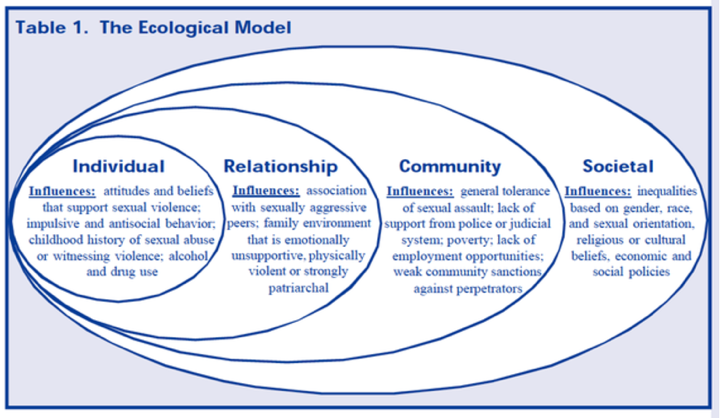Hello! My name is Jennifer Obinna and I am Research and Evaluation Director at The Improve Group, a consulting firm in Minnesota. Our evaluation practice strongly supports and encourages evaluation capacity development with our clients. One of the various ways we do so is to facilitate logic model clinics as a way to assist clients and their stakeholders articulate the desired state of their program implementation. As I often serve as an Empowerment Evaluator for sexual and domestic violence prevention efforts, I will highlight resources from that work that can be applied to any sector’s evaluation.
Social work’s person-in-environment perspective ecologically considers an individual and individual behavior within the environmental context in which that person lives and acts. In our logic model clinics, we borrow the social ecological model from public health to think through the person-in-environment as a program planning tool.

We ask stakeholders a series of questions that informs the logical framework for their program in its fully implemented and desired state.
- What assumptions—beliefs about the program, the people involved, the context, and the way the program works—do we hold?
- What resources do we have to support this?
- What activity components do we do that lead to outcomes?
- Who do we reach/influence?
- What do we produce/deliver?
For individual and relationship-level outcomes, we ask:
- What changes in learning, knowledge, attitude, skills, or understanding do we see?
- What changes in behavior, practices, or decisions do we see?
For community and societal level-outcomes, we ask:
- What changes to institutions do we see?
- What changes in condition in the community do we see?
- What changes in social norms do we see?
To dive deeper into outcomes, we use the ABCDE method of writing outcomes. Example: “By the end of the program, 80 percent of program participants will be able to list two or more positive ways to communicate with peers evidenced by the results of a pre-test/post-test survey activity.”
Rad Resource: The Ohio Domestic Violence Network Primary Prevention of Sexual and Intimate Partner Violence Empowerment Evaluation Toolkit.
Hot Tip: Stakeholders are not always enthusiastic about using paper or electronic pre-/post-tests. Therefore, we encourage “activity-based assessments,” a method that integrates evaluation into the program experience or educational curricula.
The person-in-environment perspective calls on us to make sure our logic models include “external Influences” that articulate factors outside of the implementer’s control (positive or negative) that may influence the outcomes and impact of the program/project.
Cool Trick: The clinic needs be 2 to 3 hours long per program. We convene two or three program designers/implementers in a room with a 12-by-6 foot portable sticky wall (nylon sprayed with spray mount) to facilitate laying out the logic model in a linear way together. Once documented, we encourage program staff to put the logic model elements into a diagram, shape, or symbol that resonates for them and their stakeholders. See page 15 of the Discovery Dating DELTA Evaluation Report for an example.
The American Evaluation Association is celebrating SW TIG Week with our colleagues in the Social Work Topical Interest Group. The contributions all this week to aea365 come from our SW TIG members. Do you have questions, concerns, kudos, or content to extend this aea365 contribution? Please add them in the comments section for this post on the aea365 webpage so that we may enrich our community of practice. Would you like to submit an aea365 Tip? Please send a note of interest to aea365@eval.org. aea365 is sponsored by the American Evaluation Association and provides a Tip-a-Day by and for evaluators.

Hello,
My name is Justin Garrison, I am currently learning about program evaluation. I enjoyed your out of the box thought process. Your hot tip really hit the ball park in my eyes. We have to remember that everyone learns and retains stuff different. So, bringing a direct approach might be best. Letting everyone in the office get hands on in the process may help a lot. The cool trick really opened my eyes to different ways to accomplish this. We can still do evaluations but make them fun in a way.
I really like this Jennifer. It subtly introduces a systems perspective into the traditional logic model in an accessible way.